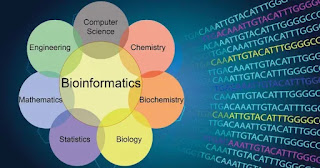What is Bioinformatics
What is Bioinformatics?
We look at the term "bioinformatics" and its meaning and meaning, we can conclude that it's a field of study that studies the biological process of information. Bioinformatics has grown to be an integral component of many areas of biology.
What is Bioinformatics: The Future? That's the question many students in graduate school ask when they think about going on a doctoral degree in this field of research. Bioinformatics is a distinct type of engineering discipline. It's not a "pure" scientific discipline. But, it has proved highly successful during its brief existence. I think the achievements have come from a comprehensive and pragmatic research method that hopes to motivate anyone interested in exploring this field.
In the field of experimental molecular biology bioinformatic methods like signal and image processing enable scientists to draw useful conclusions from huge quantities of data that are raw. For genetics it aids in the analysis and sequencing of genomes as well as their observed changes. He is involved in the analysis of biomedical literature as well as the creation of ontologies for genetics and biology to arrange and analyze biological information.
There are many connections between computer science and biology which have led to the development of other fascinating areas of research like artificial neural networks (ANN), DNA computing as well as evolutionary programming and many more. . The precise definition of bioinformatics it's not always clear since every research and biological study depend in some way on computers. A few bioinformatics-related activities involve modelling how proteins are structured, as well as developing large databases of electronic genomes, proteins, and genes. sequences.
A bioinformatics researcher uses tools and programs to study massive databases, collect samples from different locations and generate results from diagnostic tests, which can be utilized to identify and treat the disease. The actual process is much more complicated than simply constructing and managing the data set and analyzing them. Data scientists must tackle mathematical calculations and statistical analysis, the production and analysis of diagnostic test results, and the use of statistical analysis tools. All of these tasks are essential for the researchers who carry out these tasks.
The current methods employed by bioinformatics researchers rely heavily on the issues they try to answer by conducting their research. For instance, geneticists as well as genomic sequence analysts ( Coders of Sequences) Coders) examine genome sequences and decide what species the cells of the lab could be belonging. To determine this, the analysts first need to construct a family tree that includes related organisms. They then choose the species of cells they are part of based on their similarities in their codes. After that and the researcher can begin to study the biochemical processes that help these organisms function, and ultimately, gain information about how the body functions and the medical issues it faces.
A key element of bioinformatics, which sets it apart from other disciplines in science, is its ability to study massive databases and quickly efficiently access and utilize this data. Computational genomics is a type of bioinformatics that has become a significant component in medical research. This method aims to understand the whole genome - also known as the genetic code of an organism. This can give a complete understanding of the role of cells and the way that this code is expressed within the body. The exact methods for doing this are incredibly complicated. Computer programs that are proficient at imitating the designs of programmers can quickly analyze vast databases and find out about new pathways, proteins, and the genes involved in cellular processes.
Simply simply put, bioinformatics employs advanced analytical and computational methods to the analysis of biological data. Bioinformatics is used extensively in fields that require processing methods to process large amounts of data like genome sequencing. Bioinformatics also is used within the industry of pharmaceuticals to find molecular combinations that are most likely to yield useful drugs.
Bioinformatics can be used to tackle redundancy issues in databases? The problem of duplicates is common in research. When duplications happen, multiple databases have to be built for each item being studied. However, what is Bioinformatics can create redundancy within these databases, allowing researchers to conduct several tests on small numbers without wasting resources on incorrect results.
Bioinformatics can harness the power of massive databases and give users access to their information fast and effortlessly. It was difficult for scientists to analyze various databases before and required them to navigate through numerous hurdles. What could Bioinformatics do to facilitate this for researchers? It allows them to quickly and quickly access relevant databases for biological research that are specific to their field of study. The procedure involves obtaining samples and performing various tests on them that are later analyzed to determine and identify the genes, proteins, and other molecules in the samples. The software assists researchers in discovering the proteins and genes that have been expressed differently and allows them to concentrate on areas of the body in which biological information is required most.
What is Bioinformatics could be used to increase the accessibility of databases? Bioinformatics can help with this by making databases that include biological data more accessible to lookup? It allows people to look up databases that are specific to the information they require. Is bioinformatics also a way to offer simple interface controls by allowing users to choose particular areas to enter or modify within the database? It is also able to enable users to conduct various analyses on the samples that they've taken. It can, for instance, be used to construct an algorithm for genetics that can predict the outcomes of the genetic tests.
For more amazing Blogs visit- THE Tech Journal
For more details on What is API Testing visit - The Tech Journal


Comments
Post a Comment